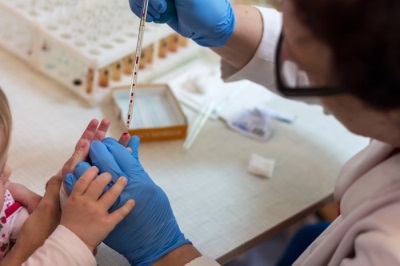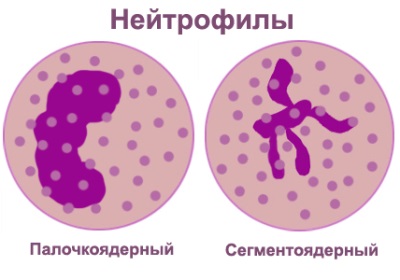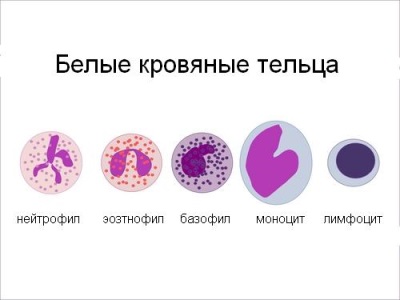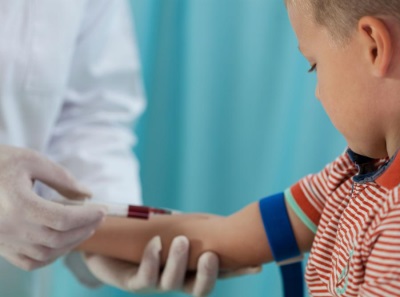Leukocyte blood count: decoding in children
Baby blood test helps the doctor find out if the baby is healthy or has any pathology. In addition to counting the total number of blood cells, hemoglobin level, hematocrit and ESR, the leukocyte formula is also determined in clinical analysis. What is hidden under this name, why should it be defined and how to decipher correctly?
What is it
Leucoformula (blood formula or leukogram) called the calculated in percent the number of different forms of white blood cells. Unlike platelets and red blood cells, white blood cells are represented by different species. In some of them there are granules, therefore such leukocytes are called granulocytes (these include basophils, neutrophils and eosinophils), in other granules there is no, therefore they are called agranulocytes (their representatives are monocytes and leukocytes).
By counting their number under a microscope, the technician expresses it as a percentage. Looking at the result of the analysis, the doctor sees how many percent of those or other white blood cells of their total number is contained in the child’s blood.
We recommend to watch the release of the program "Live healthy!", Which describes in detail what leukocytes are and how the percentage ratio of their forms in the blood formula is calculated:
Why and when determine
Although all white calves protect a child from factors unfavorable to his health, each type of white blood cell plays a role. That is why the leukocyte formula helps to clarify the diagnosis, find out the severity of the patient's condition, and also see whether the prescribed treatment is working.
The emphasis is on the popular pediatrician Komarovsky. He emphasizes that leukocytosis (an increase in the number of all leukocytes) or leukopenia (a reduced number of all white blood cells) will only help to know that a child has a disease, and with the help of a leukocyte formula, the doctor can understand what kind of pathological process occurs in the baby’s body.
For a record of Komarovsky’s program on clinical analysis of a child’s blood, see below:
Leukogram prescribed:
- Planned for preventive examination of children of a certain age (at 1 year, and then annually).
- Before performing vaccination.
- With complaints and suspicion of infection, for example, if a baby loses weight, his lymph nodes are enlarged, diarrhea appears, body temperature rises, joints ache, and so on.
- If the exacerbation of chronic disease has begun.
- If the child is preparing for surgery.
Note that the appearance of leukocyte formula is influenced by various factors, and the main one is age. The picture in the form of the analysis of a just-born child, a child at the age of 2 years or 3 years or in a teenager at 15 will be different. That is why the direction of the small patient should always be indicated on the direction. This will help the lab technician to mark higher or lower than normal rates.
Indicators of the norm and the role of different forms of leukocytes
Eosinophils
Such cells are designed to protect the child's body from allergens and parasites. The percentage of eosinophils is normally:
|
Newborns |
1-4% |
|
From 10 days of life in children up to one year |
1-5% |
|
In children older than one year |
1-4% |
Neutrophils
These most abundant white blood cells are needed to combat the pathogens. They are represented in the blood of a child in several forms that differ in their maturity:
- Young neutrophils. They are also called myelocytes and metamyelocytes. Normally, they are absent in the leukocyte formula.
- Bandworm - young neutrophil cells. Doctors are abbreviated as "sticks".
- Segmental. Such neutrophils are fully mature cells and normally they should prevail among all neutrophilic leukocytes.
The normal content of stab cells immediately after birth is called 5-12%, but by the fifth day after birth, their number drops to 1-5% and remains so until 5 years of age. In children older than 5 years, 1–4% is considered the norm of stab neutrophils.
The rate of segmented cells is presented in the table:
|
On the first day of life |
50-70% |
|
On the fifth day of life |
35-55% |
|
In 1 month |
17-30% |
|
In 1 year |
20-35% |
|
At 5 years old |
35-55% |
|
With 10 years |
40-60% |
Basophils
Monocytes
These cells are converted into macrophages and absorb microbes, dead cells and other substances, removing them from the child's body. Normally, the number of monocytes from the total number of leukocytes is represented by such a percentage:
|
Have a newborn |
4-10% |
|
From the 5th day of life to 1 month |
6-14% |
|
From 1 month to a year |
5-12% |
|
In 1 year |
4-10% |
|
From the age of 5 |
4-6% |
|
In children over 15 years |
3-7% |
A video on what monocytes are can be viewed here:
Lymphocytes
This type of white blood cells is quite numerous and, like neutrophils, is represented by different forms, but in the general analysis of blood, individual types of lymphocytes are not determined. The main task of these cells is to participate in immune responses. They actively protect children from viruses. The norm of lymphocytes in children of different ages is considered:
|
Immediately after birth |
16-32% |
|
With 5 days of life |
30-50% |
|
On the 10th day of life |
40-60% |
|
From the 1st month |
45-60% |
|
In children older than one year |
45-65% |
|
At 5 years old |
35-55% |
|
From the age of 10 |
30-45% |
How to decipher the results
The doctor should evaluate the leukogram, comparing its data with the existing symptoms and other examinations of the child.
Minor deviations
The ratio of leukocytes may vary slightly due to:
- Emotional load.
- Physical activity.
- Eating before giving blood.
- Taking some medication.
The change in the number of neutrophils
If neutrophils are elevated compared to other leukocytes, this is called neutrophilia, and a decrease in the number of such cells is called neutropenia. The main reasons for these changes are:
Above normal | Below normal |
Bacterial infection | Rubella, hepatitis, chickenpox, flu |
Infection with fungi, protozoa and some viruses | Bone marrow damage during chemotherapy or radiotherapy |
Inflammatory process (dermatitis, arthritis, rheumatism, pancreatitis and etc.) | Spleen hyperfunction |
Tumor | Anemia |
Poisoning | Leukemia and other neoplasms |
Diabetes | Cytotoxic drugs and other drugs |
Some medications | Anaphylaxis |
Postoperative period | Congenital abnormalities |
Sepsis | Thyrotoxicosis |
Blood loss | B12 deficiency anemia |
Shift left
Shift right
Change in the number of basophils
A decrease in basophils in the blood is very rare and is not a diagnostically important sign.
Change in the number of lymphocytes
If such cells are determined in excess of the quantity, it is called lymphocytosis. The lack of this type of leukocytes in the blood is lymphocytopenia. Most often such conditions are caused by such problems:
|
Above normal |
Below normal |
|
Viral infections (ARVI, hepatitis, mononucleosis, whooping cough, HIV and others) |
Immunodeficiency (both acquired and congenital) |
|
Blood cancer |
Aplastic anemia |
|
Poisoning |
Systemic diseases |
|
Acceptance of some medications |
Tuberculosis |
|
Splenectomy |
Lymphoma or Hodgkin's disease |
|
Radiation sickness |
|
|
Renal failure |
Change in the number of eosinophils
An increased number of such cells is called eosinophilia and is diagnosed with:
- Worm invasions.
- Infection with the simplest.
- Allergic reactions.
- Leukemia
- Scarlet fever and rheumatism.
- Malaria.
- Mononucleosis.
- Extensive burns.
- Acute bacterial infections.
A decrease in the percentage of eosinophils, which is called “eosinopenia”, is very rare in children and may be due to an inflammatory process in the initial stage or a severe purulent infection. Also, the number of these white cells decreases due to treatment with glucocorticoids or heavy metal poisoning.
Change in the number of monocytes
The excess of the norm of such cells is called monocytosis and is determined by:
- Mononucleosis.
- Tuberculosis.
- Autoimmune diseases.
- Leukemia and other cancers.
- Rheumatism.
- Ulcerative colitis.
- Parasitic diseases.
A decrease in the level of monocytes (monocytopenia) is characteristic of the postoperative period, depletion of the body, sepsis or the use of steroids. Also, the number of monocytes is reduced after chemotherapy or exposure to radiation.


















